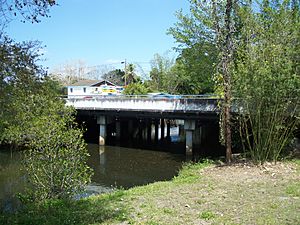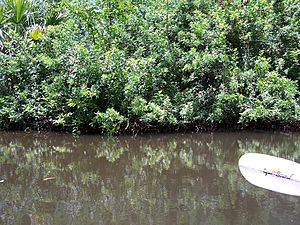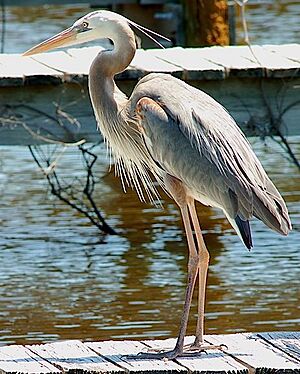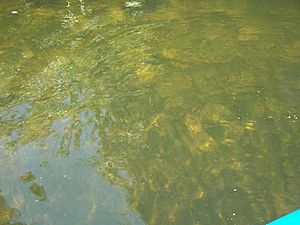Estero River (Florida) facts for kids
Quick facts for kids Estero River |
|
|---|---|
| Country | United States |
| Physical characteristics | |
| River mouth | Estero Bay |
| Basin features | |
| Basin size | Estero Bay |
The Estero River is a 6.4-mile (10.3 km) long waterway in south Lee County, Florida, United States. It is located near the town of Estero. The river flows from east to west. It eventually empties into Estero Bay, which is an inlet of the Gulf of Mexico.
Contents
Exploring the Estero River
You can find the Estero River at 26°26′N 81°49′W / 26.43°N 81.81°W. The river's western end meets Estero Bay. Its eastern end is about three miles east of I-75.
The river banks change as you move along. Towards the east, you'll see more houses and communities. But along the western banks, closer to the bay, there's a lot more natural plant and animal life.
Wildlife of the Estero River
The Estero River is home to many different kinds of plants and animals. It's a very important place for animals that are in danger of disappearing. These include the American alligator (Alligator mississippiensis) and the whooping crane (Grus americana).
Mangroves and River Life
The trees called mangroves grow along the river banks. They are very important for the river's many animals. Most mangroves are found where the Estero River flows into Estero Bay.
Birds of the River
The great blue heron (Ardea herodias) lives and raises its young near the Estero River. It likes both salty and fresh water. These herons build their nests high in the trees around the river. They mostly eat insects that live in or near the water.
The great egret (Ardea alba) also lives here. It eats small mammals, amphibians, and sometimes insects. It doesn't compete with the great blue heron for food.
You might also spot the tricolored heron (Egretta tricolor) in the early morning. It eats insects and small amphibians. This heron builds its nests closer to the ground. It can live alongside the great blue heron.
Other Animals
American alligators (Alligator mississippiensis) live along the Estero River. They help keep the river's animal populations balanced. For example, they help control the number of raccoons. Alligators mostly eat small mammals, birds, and larger amphibians. You are more likely to see them in the western part of the river.
Raccoons (Procyon lotor) are common animals here. They are usually active at night. Raccoons eat many different things, like berries, plants, small animals, and insects. Sometimes you can see them during the day. They are used to being around people.
Insects and Spiders
The Estero River is a great place for insects. Many types of mosquitoes live near the river. Female mosquitoes need blood to lay their eggs. Both male and female mosquitoes drink plant nectar and help pollinate plants.
You can also find many orb-weaver spiders along the river banks. These spiders are easy to spot because of their round webs. They eat small insects. Bees can sometimes be seen nesting in trees that hang over the river.
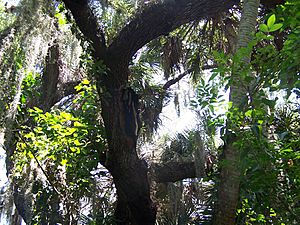
How Humans Affect the River
The water quality in the eastern part of the river is not as good as in the western part. This is because more houses and buildings are being built in the Estero area. Waste from these developments can affect the water.
The water quality gets much better the further you go from drainage pipes and houses. Since most building happens in the eastern parts of the river, the water quality is lower there.
History of the Estero River
The first people to live near the Estero River were the Calusa Indians. They arrived about 7,000 years ago. The Calusa used the river for travel and to find food, especially by fishing. They depended a lot on the river. Many of their important historical sites are around the Caloosahatchee River. This is where they first met European settlers. Old tools and other items from the Calusa are still being found in the area.
The Calusa first met Europeans around 1513. This was when the Spanish explorer Juan Ponce de León arrived. After this, the Calusa population began to shrink.
The river's recorded history began in 1882. That's when Gustave Damkohler found the river and lived there with his family. In 1894, he met Cyrus Teed in Chicago, Illinois. Teed was the leader of a new religious group called Koreshanity. Damkohler offered Teed 300 acres of land in Estero, which included access to the river.
Cyrus Teed and a small group of his followers moved to Florida. They arrived at Estero Bay and traveled up the Estero River. This area is now known as the Koreshan State Park. They built a community and invited more followers to join them from Chicago.
The Koreshans had a big impact on the river. They used it every day to travel in and out of Estero Bay. They hunted and gathered food from Mound Key. This is an island just west of the Estero River's entrance to the bay. They used canoes, which were the fastest way to travel back then. They also fished in the river.
The Koreshans believed the Earth was like a cell, and they lived inside it. They lived by the Estero River until 1961. At that time, their land was given to the state of Florida. The Koreshan group had been getting smaller since 1908, when Cyrus Teed died. Today, you can visit the Koreshan State Park. There, you can learn about the Koreshan people and their history. You can still go canoeing, kayaking, boating, and fishing on the Estero River today.
The Estero River is still connected to the history of Florida. Today, new buildings have been built along the river. It has become a well-known landmark. You can still access the river for about 6.4 miles inland to Estero Bay. Many boaters who live on the river visit Mound Key, just like the Calusa did long ago. The river is now mostly used for sport fishing and sightseeing. Even though hurricanes Wilma and Charley caused damage in the past, the river is still open for boating.


